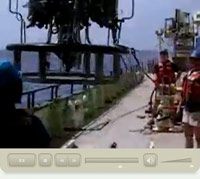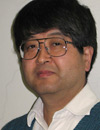|
  Today's Weather Partly cloudy Lat: 03° 58’S Long: 12° 13’W Air Temp: 77.8°F Bar Pressure: 1011.6 mbar Sea Temp: 79.8°F Sea State: 4-6 ft Swell Height: <7 ft, ESE Wind: SE; 7-10 knots Visibility: Unlimited
January 7, 2008 (posted January 8, 2008) by Susan Humphris, edited by Kristen Kusek While others slept soundly in their bunks last night, the “tow-yo team,” (see yesterday’s update) geologist Ko-ichi Nakamura and undergraduate Miyabi Nakamura, were wide awake—working hard into the night. They spent about eighteen hours tow-yo-ing the CTD “British and U.S. scientists collected evidence for a hydrothermal plume in this same area in 2005, but now it’s 2008—and the ocean is a dynamic place,” said Ko-ichi. “Is the plume still here? If so, where is its source? Could there be more than one?” Each of our instruments being towed through the pitch-black ocean depths is searching for a different telltale clue to help us find out. Just as smoke from a chimney blows in the wind, a hydrothermal plume drifts with the currents. So even though the hydrothermal vent might still be active, the plume could be wafting around in a different place from where it was first detected. It’s tough to pin the plume cloud down, and we’re lucky to have technology, like the CTD and other sensors, to help us out. The CTD (conductivity-temperature-depth instrument) can detect very small differences in temperature, and from the CTD pressure measurements, scientists can calculate the water depths at which those temperature differences are observed. (Remember: pressure in the ocean changes by 1 atmosphere for every 10 meters of water depth.) The CTD also measures electrical conductivity, a measure of the salinity (or saltiness) of the ocean. But hydrothermal fluids discharging from seafloor vents are not generally all that different in salinity from “normal” seawater, so salinity doesn’t help us much in our search for plumes. There’s another instrument piggy-backing on our CTD system that measures something called “optical backscatter,” which is a measure of the number of particles suspended in the water. Imagine driving in your car through a fog: Sometimes the fog is thick (where there are lots of water droplets in the air) and you cannot see very far. Other times, when there are fewer water droplets, you can see a longer distance. Hydrothermal plumes contain a large number of suspended particles, whereas the “regular” deep ocean is pretty clear, so scientists have found optical backscatter to be a sensitive indicator of a hydrothermal plume. And then there is Ko-ichi’s favorite sensor, the one that he has brought all the way from his lab in Japan. This sensor measures something called redox potential, which scientists call (perhaps oddly) “Eh” for short. Eh indicates how chemically reactive a fluid might be. “Hydrothermal vents contain chemicals such as hydrogen sulfide, which cause the Eh to decrease in value,” explained Ko-ichi. “These chemicals do not last very long in the ocean because they react quickly. If we see a low Eh, we know we are quite close to a vent.” At around 11:00 pm last night, as he was sitting staring at the computer screen that displays all the sensor information, Ko-ichi noticed a ”hit” at a water depth of around Around dawn this morning, we repositioned the ship to do a second tow-yo perpendicular to the first. Throughout much of the day, we found signals of a distant hydrothermal plume. And then, it happened: the Eh signal started dropping rapidly on the screen, indicating that we were getting much closer now! A cheer exploded from the main lab at around 6:00 p.m., just as everyone finished dinner. Our next job is to define a “bull’s eye,” but in this case it will be a box measuring 4 kilometers by 4 kilometers (about 2.5 miles x 2.5 miles). That will be our target to search for vents. After a few more CTD tow-yos, it will finally be time to let the robotic “cats” go hunting—using new commnications techniques to do it! Ko-ichi Nakamura: Born and raised in Japan, his early interest was in volcanoes, which led to marine geology and hydrothermal vent systems. Read the interview »
[ Previous day ] [ Next day ]
|
||
Mailing List | Feedback | Glossary | For Teachers | About Us | Contact
© 2010 Dive and Discover™. Dive and Discover™ is a registered trademark of Woods
Hole Oceanographic Institution




